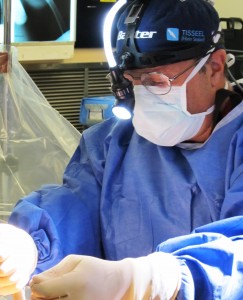Patients should do their research and should try to get the best total knee replacement they can. It always surprises me how many of my patients wait too long to fix their arthritic knees because they have heard that “total knees don’t last very long”. Actually, the results of knee replacements keep getting better over time. It isn’t really only about which device is used. I think a lot f it has to do with finding a surgeon who specializes in knee replacement. Studies have shown that higher volume total joint centers tend to have better results and less complications. You do need to do a little online research to find a qualified and experienced total knee surgeon. Look for a surgeon who has done an extra year of training called a “total joint replacement fellowship”. (PS: Dr. Kozinn did his joint replacement fellowship at Harvard Medical College at the Brigham and Women’s Hospital in Boston.)
Research suggests that approximately 85% of modern total knees will function well over 20 years ( assuming the patient survives that long). Patients are happier in the short term with new pain management techniques as well. The reasons for success are better materials, better implants, better techniques, better pain management, and better understanding of the rehab process needed. For instance, I have found that waiting a week before starting painful therapy exercises helps decrease initial bleeding and swelling and pain, and actually results in a faster recovery – possibly the opposite of what you might expect. In the end, the knee replacement surgery is a “controlled trauma”, and allowing for some initial healing goes a long way towards faster recovery. We also flex our knees over a pillow the first night of surgery. Some surgeons avoid this because they assume “it may make it harder to get the knee straight”. This is not true! The flexed knee is more comfortable, particularly when using a femoral nerve block to control pain, as it relaxes the posterior ligaments. It also has the added benefit of stopping any residual bleeding in the knee ( indirectly by tensing the soft tissues – the bleeding stops by itself!). I also believe that a drainage tube in most cases will decrease pain and swelling by allowing the collected blood to escape after the surgery. We are designing a home based “self directed ” rehabe program that will allow many total knee patients to avoid the hassles and inconvenience of so many therapy visits. Every patient is different, so we customize the rehab program to the patients needs.
Using a spinal anesthesia also greatly reduces the mental perception of pain, and as the pain returns gradually after surgery, it allows the mind time to accommodate to the pain by and generating the body’s own endorphins ( morhpine like substance that your body creates when it senses trauma or pain). The spinal anesthesia is SAFER than a general anesthesia, because you continue to breathe on your own, without the need for paralytic medications and a machine to breathe for you through a tube. The bottom line is – there is more to the success of a knee replacement then the surgery itself. You need to find a qualified expert – just like you would for any important procedure you might want to have done – Ask your surgeon if he has done a Joint Replacement Fellowship, and how many joints a year he does. Expert total knee surgeons will do over 100 procedures a year, and their results have been shown to be better ( practice makes perfect! ). Dr. Kozinn has been doing 200 to 300 total knees a year for over 20 years – and that is called : EXPERIENCE
